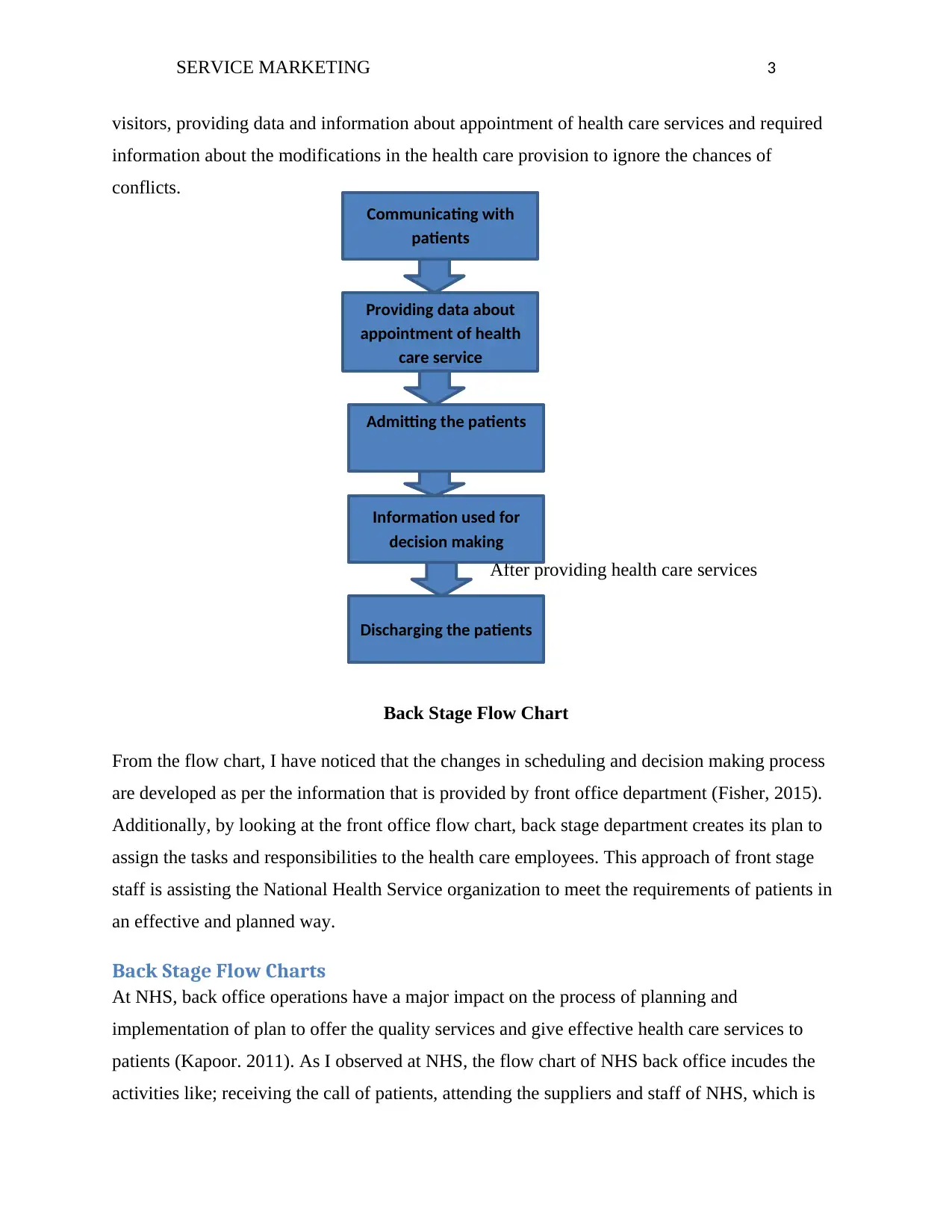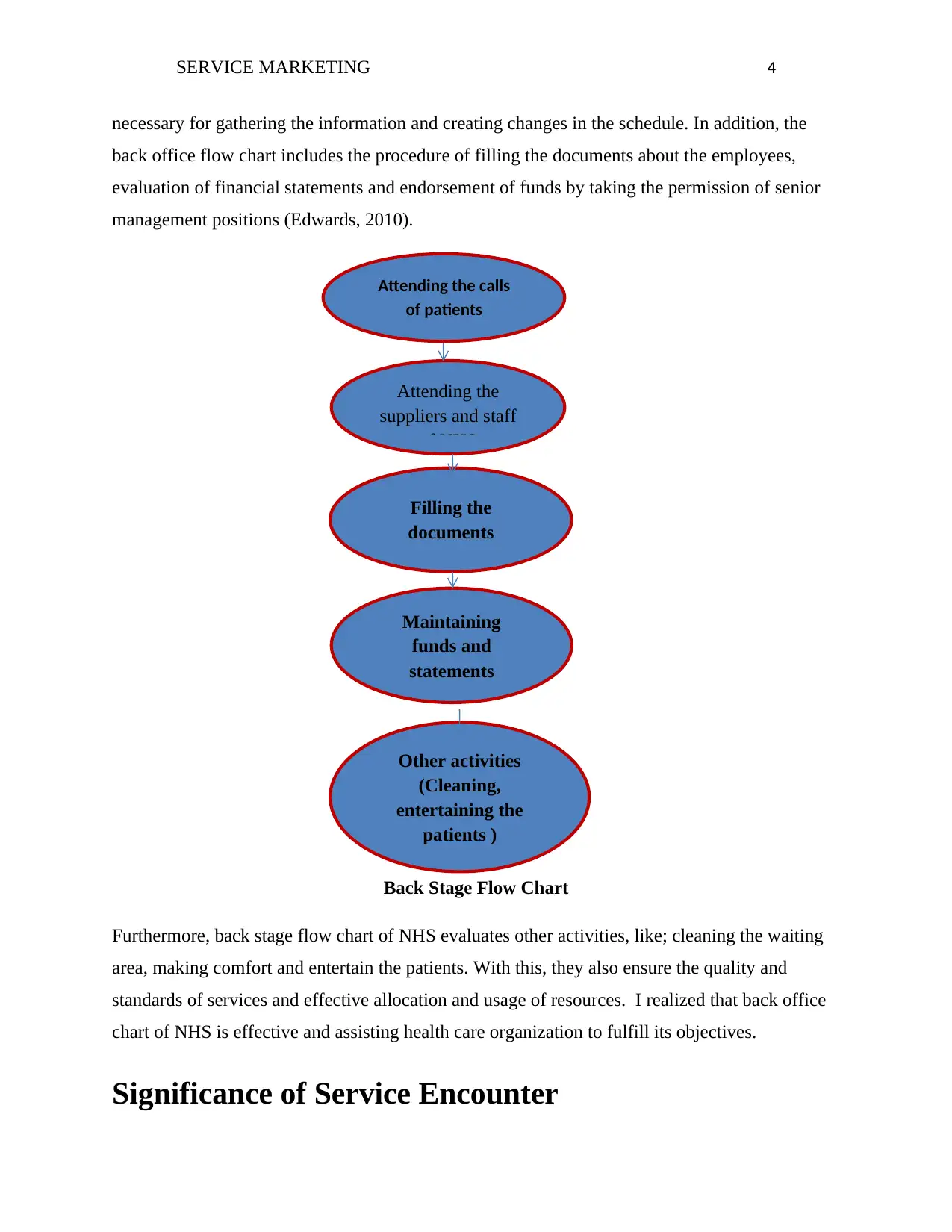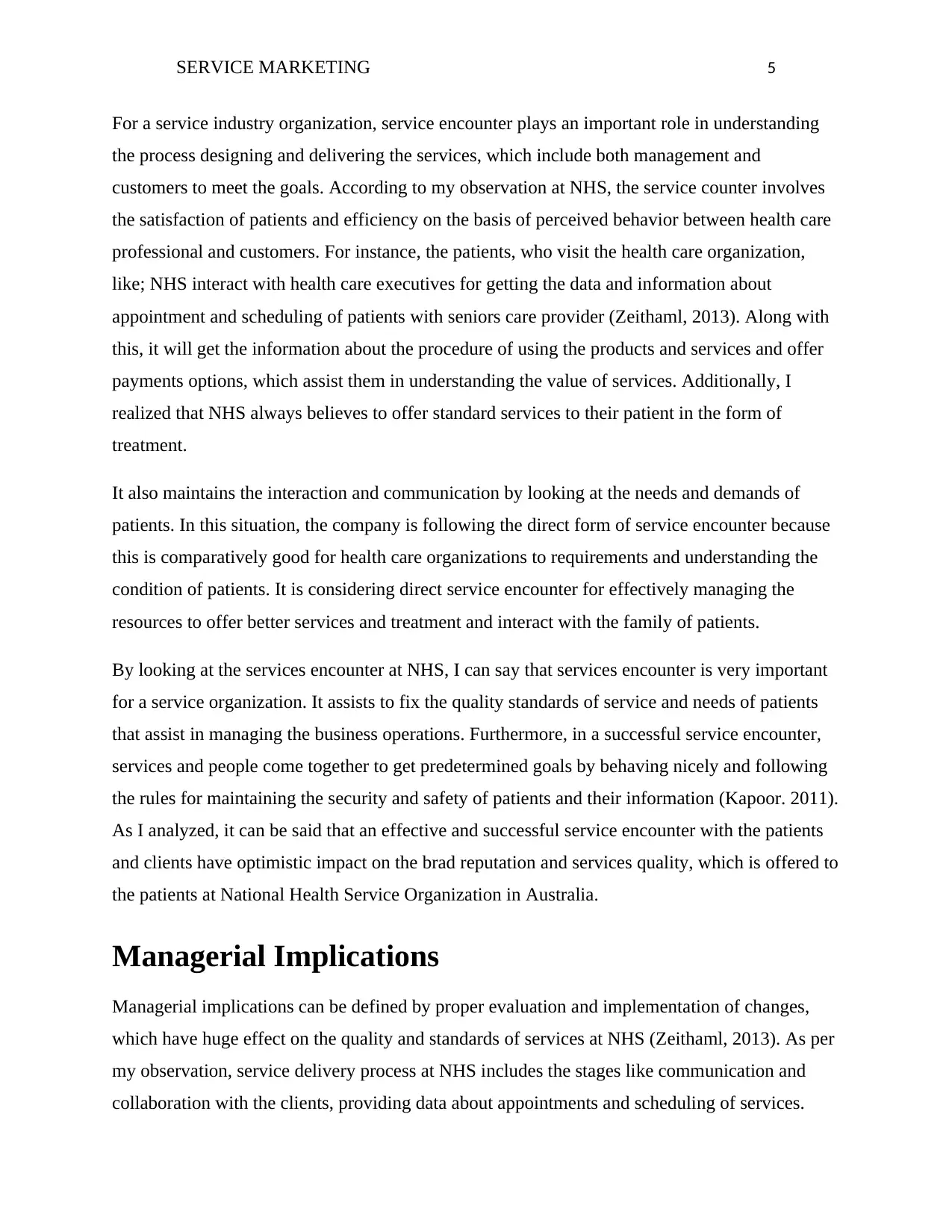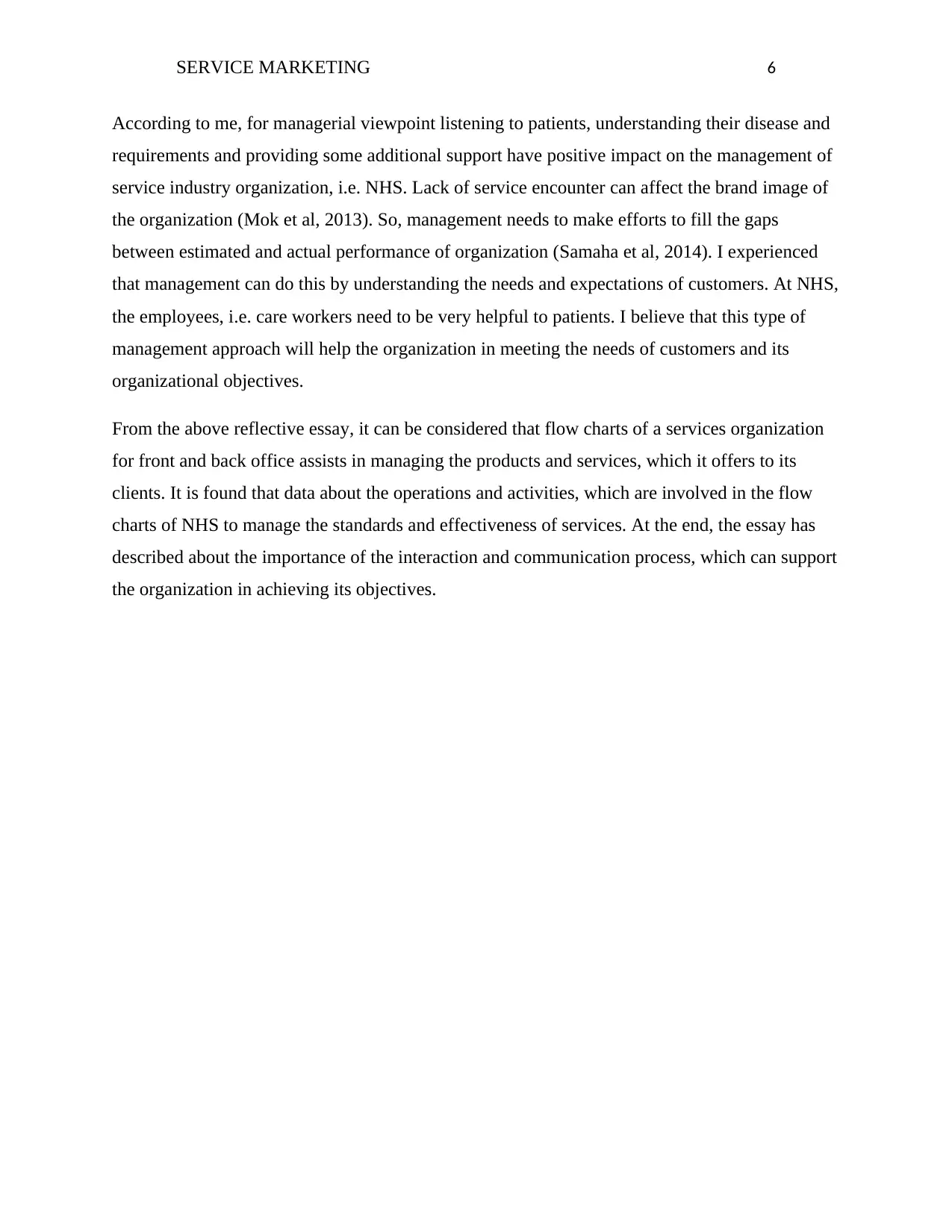Service Marketing and Relationship Marketing Analysis: NHS Report
VerifiedAdded on 2020/03/04
|7
|1755
|163
Report
AI Summary
This report analyzes service marketing and relationship marketing within the National Health Service (NHS) in Australia. It explores the importance of effective employee interaction and communication between front-stage and back-stage divisions for delivering quality healthcare services. The report uses flow charts to illustrate the front and back office operations at NHS, highlighting activities such as patient communication, appointment scheduling, and resource management. It examines the significance of service encounters, focusing on patient satisfaction and the interactions between healthcare professionals and patients. Furthermore, the report evaluates the managerial implications of the designed flow charts, emphasizing the need to understand patient needs and expectations to maintain a positive brand image and achieve organizational objectives. The author, working as a caretaker at NHS, provides practical insights into the application of service marketing principles within a healthcare setting, emphasizing the importance of direct service encounters and effective resource management.

Running Head: SERVICE MARKETING 1
Service Marketing and Relationship Marketing
Service Marketing and Relationship Marketing
Paraphrase This Document
Need a fresh take? Get an instant paraphrase of this document with our AI Paraphraser

SERVICE MARKETING 2
For a services organization, it is very important to establish proper and effective interaction
among its employees. It is very necessary for managing the activities and operations in effective
and professional way. The organization makes efforts to maintain effective communication
between its front stage and back stage divisions. For offering quality services to the customers,
management of organization has to categorize these two divisions. In this reflective essay, there
is a discussion about the front office and back office flow charts of National Health Services. It
will analyze the importance of service counter at health service organization. At the end, it will
evaluate the managerial implications of designed flow charts and effectiveness of service
encounter to achieve the goals of organization.
Flow Charts
Currently, I am working in well-established health services organization in Australia, i.e.
National Health Services (NHS). I am working here as a care taker from 2016. NHS is the
biggest health care organization in Australia that is funded by public. It is providing all types of
health care services to the patients. It is also giving them support for maintaining their health and
life style. At NHS, the senior management has established two departments, i.e. back stage and
front stage for evaluating, creating and offering the services to the patients (Armstrong et al,
2014).
Each and every product based or service based organization create flow charts for planning,
organizing and supervising the operations according to the set quality and standards. For NHS,
designing of the flowcharts is necessary for attaining the preset standards and managing the
organizational culture of providing the services. An effective balance between back and front
stage flow charts will have huge impact on the process used for attaining the objectives of
business (Christopher et al, 2013).
Front Stage Flow Charts
At NHS, there are some specific operations and services, which are assigned to the front stage
staff, like; managing the quality and standards, coordination and collection of admitting and
discharging patients (Goetsch and Davis, 2014). Front office staff of organization follows a flow
chart that is created by the top level management. As I observed at NHS, front office flow chart
of the organization includes different activities like; communication with the patients and other
For a services organization, it is very important to establish proper and effective interaction
among its employees. It is very necessary for managing the activities and operations in effective
and professional way. The organization makes efforts to maintain effective communication
between its front stage and back stage divisions. For offering quality services to the customers,
management of organization has to categorize these two divisions. In this reflective essay, there
is a discussion about the front office and back office flow charts of National Health Services. It
will analyze the importance of service counter at health service organization. At the end, it will
evaluate the managerial implications of designed flow charts and effectiveness of service
encounter to achieve the goals of organization.
Flow Charts
Currently, I am working in well-established health services organization in Australia, i.e.
National Health Services (NHS). I am working here as a care taker from 2016. NHS is the
biggest health care organization in Australia that is funded by public. It is providing all types of
health care services to the patients. It is also giving them support for maintaining their health and
life style. At NHS, the senior management has established two departments, i.e. back stage and
front stage for evaluating, creating and offering the services to the patients (Armstrong et al,
2014).
Each and every product based or service based organization create flow charts for planning,
organizing and supervising the operations according to the set quality and standards. For NHS,
designing of the flowcharts is necessary for attaining the preset standards and managing the
organizational culture of providing the services. An effective balance between back and front
stage flow charts will have huge impact on the process used for attaining the objectives of
business (Christopher et al, 2013).
Front Stage Flow Charts
At NHS, there are some specific operations and services, which are assigned to the front stage
staff, like; managing the quality and standards, coordination and collection of admitting and
discharging patients (Goetsch and Davis, 2014). Front office staff of organization follows a flow
chart that is created by the top level management. As I observed at NHS, front office flow chart
of the organization includes different activities like; communication with the patients and other

SERVICE MARKETING 3
visitors, providing data and information about appointment of health care services and required
information about the modifications in the health care provision to ignore the chances of
conflicts.
After providing health care services
Back Stage Flow Chart
From the flow chart, I have noticed that the changes in scheduling and decision making process
are developed as per the information that is provided by front office department (Fisher, 2015).
Additionally, by looking at the front office flow chart, back stage department creates its plan to
assign the tasks and responsibilities to the health care employees. This approach of front stage
staff is assisting the National Health Service organization to meet the requirements of patients in
an effective and planned way.
Back Stage Flow Charts
At NHS, back office operations have a major impact on the process of planning and
implementation of plan to offer the quality services and give effective health care services to
patients (Kapoor. 2011). As I observed at NHS, the flow chart of NHS back office incudes the
activities like; receiving the call of patients, attending the suppliers and staff of NHS, which is
Communicating with
patients
Providing data about
appointment of health
care service
Admitting the patients
Information used for
decision making
Discharging the patients
visitors, providing data and information about appointment of health care services and required
information about the modifications in the health care provision to ignore the chances of
conflicts.
After providing health care services
Back Stage Flow Chart
From the flow chart, I have noticed that the changes in scheduling and decision making process
are developed as per the information that is provided by front office department (Fisher, 2015).
Additionally, by looking at the front office flow chart, back stage department creates its plan to
assign the tasks and responsibilities to the health care employees. This approach of front stage
staff is assisting the National Health Service organization to meet the requirements of patients in
an effective and planned way.
Back Stage Flow Charts
At NHS, back office operations have a major impact on the process of planning and
implementation of plan to offer the quality services and give effective health care services to
patients (Kapoor. 2011). As I observed at NHS, the flow chart of NHS back office incudes the
activities like; receiving the call of patients, attending the suppliers and staff of NHS, which is
Communicating with
patients
Providing data about
appointment of health
care service
Admitting the patients
Information used for
decision making
Discharging the patients
⊘ This is a preview!⊘
Do you want full access?
Subscribe today to unlock all pages.

Trusted by 1+ million students worldwide

SERVICE MARKETING 4
necessary for gathering the information and creating changes in the schedule. In addition, the
back office flow chart includes the procedure of filling the documents about the employees,
evaluation of financial statements and endorsement of funds by taking the permission of senior
management positions (Edwards, 2010).
Back Stage Flow Chart
Furthermore, back stage flow chart of NHS evaluates other activities, like; cleaning the waiting
area, making comfort and entertain the patients. With this, they also ensure the quality and
standards of services and effective allocation and usage of resources. I realized that back office
chart of NHS is effective and assisting health care organization to fulfill its objectives.
Significance of Service Encounter
Attending the
suppliers and staff
of NHS
Filling the
documents
Maintaining
funds and
statements
Other activities
(Cleaning,
entertaining the
patients )
Attending the calls
of patients
necessary for gathering the information and creating changes in the schedule. In addition, the
back office flow chart includes the procedure of filling the documents about the employees,
evaluation of financial statements and endorsement of funds by taking the permission of senior
management positions (Edwards, 2010).
Back Stage Flow Chart
Furthermore, back stage flow chart of NHS evaluates other activities, like; cleaning the waiting
area, making comfort and entertain the patients. With this, they also ensure the quality and
standards of services and effective allocation and usage of resources. I realized that back office
chart of NHS is effective and assisting health care organization to fulfill its objectives.
Significance of Service Encounter
Attending the
suppliers and staff
of NHS
Filling the
documents
Maintaining
funds and
statements
Other activities
(Cleaning,
entertaining the
patients )
Attending the calls
of patients
Paraphrase This Document
Need a fresh take? Get an instant paraphrase of this document with our AI Paraphraser

SERVICE MARKETING 5
For a service industry organization, service encounter plays an important role in understanding
the process designing and delivering the services, which include both management and
customers to meet the goals. According to my observation at NHS, the service counter involves
the satisfaction of patients and efficiency on the basis of perceived behavior between health care
professional and customers. For instance, the patients, who visit the health care organization,
like; NHS interact with health care executives for getting the data and information about
appointment and scheduling of patients with seniors care provider (Zeithaml, 2013). Along with
this, it will get the information about the procedure of using the products and services and offer
payments options, which assist them in understanding the value of services. Additionally, I
realized that NHS always believes to offer standard services to their patient in the form of
treatment.
It also maintains the interaction and communication by looking at the needs and demands of
patients. In this situation, the company is following the direct form of service encounter because
this is comparatively good for health care organizations to requirements and understanding the
condition of patients. It is considering direct service encounter for effectively managing the
resources to offer better services and treatment and interact with the family of patients.
By looking at the services encounter at NHS, I can say that services encounter is very important
for a service organization. It assists to fix the quality standards of service and needs of patients
that assist in managing the business operations. Furthermore, in a successful service encounter,
services and people come together to get predetermined goals by behaving nicely and following
the rules for maintaining the security and safety of patients and their information (Kapoor. 2011).
As I analyzed, it can be said that an effective and successful service encounter with the patients
and clients have optimistic impact on the brad reputation and services quality, which is offered to
the patients at National Health Service Organization in Australia.
Managerial Implications
Managerial implications can be defined by proper evaluation and implementation of changes,
which have huge effect on the quality and standards of services at NHS (Zeithaml, 2013). As per
my observation, service delivery process at NHS includes the stages like communication and
collaboration with the clients, providing data about appointments and scheduling of services.
For a service industry organization, service encounter plays an important role in understanding
the process designing and delivering the services, which include both management and
customers to meet the goals. According to my observation at NHS, the service counter involves
the satisfaction of patients and efficiency on the basis of perceived behavior between health care
professional and customers. For instance, the patients, who visit the health care organization,
like; NHS interact with health care executives for getting the data and information about
appointment and scheduling of patients with seniors care provider (Zeithaml, 2013). Along with
this, it will get the information about the procedure of using the products and services and offer
payments options, which assist them in understanding the value of services. Additionally, I
realized that NHS always believes to offer standard services to their patient in the form of
treatment.
It also maintains the interaction and communication by looking at the needs and demands of
patients. In this situation, the company is following the direct form of service encounter because
this is comparatively good for health care organizations to requirements and understanding the
condition of patients. It is considering direct service encounter for effectively managing the
resources to offer better services and treatment and interact with the family of patients.
By looking at the services encounter at NHS, I can say that services encounter is very important
for a service organization. It assists to fix the quality standards of service and needs of patients
that assist in managing the business operations. Furthermore, in a successful service encounter,
services and people come together to get predetermined goals by behaving nicely and following
the rules for maintaining the security and safety of patients and their information (Kapoor. 2011).
As I analyzed, it can be said that an effective and successful service encounter with the patients
and clients have optimistic impact on the brad reputation and services quality, which is offered to
the patients at National Health Service Organization in Australia.
Managerial Implications
Managerial implications can be defined by proper evaluation and implementation of changes,
which have huge effect on the quality and standards of services at NHS (Zeithaml, 2013). As per
my observation, service delivery process at NHS includes the stages like communication and
collaboration with the clients, providing data about appointments and scheduling of services.

SERVICE MARKETING 6
According to me, for managerial viewpoint listening to patients, understanding their disease and
requirements and providing some additional support have positive impact on the management of
service industry organization, i.e. NHS. Lack of service encounter can affect the brand image of
the organization (Mok et al, 2013). So, management needs to make efforts to fill the gaps
between estimated and actual performance of organization (Samaha et al, 2014). I experienced
that management can do this by understanding the needs and expectations of customers. At NHS,
the employees, i.e. care workers need to be very helpful to patients. I believe that this type of
management approach will help the organization in meeting the needs of customers and its
organizational objectives.
From the above reflective essay, it can be considered that flow charts of a services organization
for front and back office assists in managing the products and services, which it offers to its
clients. It is found that data about the operations and activities, which are involved in the flow
charts of NHS to manage the standards and effectiveness of services. At the end, the essay has
described about the importance of the interaction and communication process, which can support
the organization in achieving its objectives.
According to me, for managerial viewpoint listening to patients, understanding their disease and
requirements and providing some additional support have positive impact on the management of
service industry organization, i.e. NHS. Lack of service encounter can affect the brand image of
the organization (Mok et al, 2013). So, management needs to make efforts to fill the gaps
between estimated and actual performance of organization (Samaha et al, 2014). I experienced
that management can do this by understanding the needs and expectations of customers. At NHS,
the employees, i.e. care workers need to be very helpful to patients. I believe that this type of
management approach will help the organization in meeting the needs of customers and its
organizational objectives.
From the above reflective essay, it can be considered that flow charts of a services organization
for front and back office assists in managing the products and services, which it offers to its
clients. It is found that data about the operations and activities, which are involved in the flow
charts of NHS to manage the standards and effectiveness of services. At the end, the essay has
described about the importance of the interaction and communication process, which can support
the organization in achieving its objectives.
⊘ This is a preview!⊘
Do you want full access?
Subscribe today to unlock all pages.

Trusted by 1+ million students worldwide

SERVICE MARKETING 7
References
Armstrong, G., Adam, S., Denize, S. and Kotler, P. (2014). Principles of marketing. Pearson
Australia.
Christopher, M., Payne, A., & Ballantyne, D. (2013). Relationship marketing. Taylor & Francis.
Edwards, M. (2010). Communication skills for nurses. A practical guide on how to achieve
successful consultations. London: Quay Books.
Fisher, A. (2015). Health and social care. Oxford: Heinemann.
Goetsch, D.L. and Davis, S.B. (2014). Quality management for organizational excellence. Upper
Saddle River, NJ: pearson.
Kapoor. (2011). Service Marketing: Concepts & Practices. Tata McGraw-Hill Education.
Mok, C., Sparks, B., & Kadampully, J, (2013). Service quality management in hospitality,
tourism, and leisure. Routledge.
Samaha, S. A., Beck, J. T., & Palmatier, R. W. (2014). The role of culture in international
relationship marketing. Journal of Marketing, 78(5), 78-98.
Zeithaml. (2013). Services Marketing: Integrating Customer Focus Across the Firm. Tata
McGraw-Hill Education.
References
Armstrong, G., Adam, S., Denize, S. and Kotler, P. (2014). Principles of marketing. Pearson
Australia.
Christopher, M., Payne, A., & Ballantyne, D. (2013). Relationship marketing. Taylor & Francis.
Edwards, M. (2010). Communication skills for nurses. A practical guide on how to achieve
successful consultations. London: Quay Books.
Fisher, A. (2015). Health and social care. Oxford: Heinemann.
Goetsch, D.L. and Davis, S.B. (2014). Quality management for organizational excellence. Upper
Saddle River, NJ: pearson.
Kapoor. (2011). Service Marketing: Concepts & Practices. Tata McGraw-Hill Education.
Mok, C., Sparks, B., & Kadampully, J, (2013). Service quality management in hospitality,
tourism, and leisure. Routledge.
Samaha, S. A., Beck, J. T., & Palmatier, R. W. (2014). The role of culture in international
relationship marketing. Journal of Marketing, 78(5), 78-98.
Zeithaml. (2013). Services Marketing: Integrating Customer Focus Across the Firm. Tata
McGraw-Hill Education.
1 out of 7
Related Documents
Your All-in-One AI-Powered Toolkit for Academic Success.
+13062052269
info@desklib.com
Available 24*7 on WhatsApp / Email
![[object Object]](/_next/static/media/star-bottom.7253800d.svg)
Unlock your academic potential
Copyright © 2020–2025 A2Z Services. All Rights Reserved. Developed and managed by ZUCOL.





